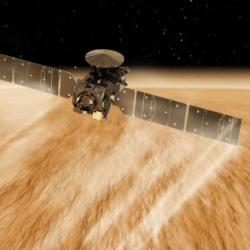The dust that is released from the comet nucleus typically has only a small velocity relative to the nucleus. It will therefore follow more or less the orbit of the cometary nucleus, that is, a curved elliptical or parabolic trajectory.
Pushed by the light of the Sun
A large fraction of this dust is very small, with typical dust grain diameters of 0.001 mm. Because of their large surface to mass ratio these grains are very sensitive to the solar radiation pressure, that is, the pressure exerted by the light of the Sun on these particles.
They will therefore be pushed behind the comet, so that the dust grains form a diffuse dust tail trailing behind the comet, more or less along the curved orbit. The degree to which the dust deviates from the comet orbit depends on the size of the dust grains.
Dust reflects sunlight
This dust tail has a yellow-white appearance, as the dust particles simply reflect the incident sunlight.
The straight bluish and highly structured plasma tail and the curved diffuse white dust tail are clearly visible in the accompanying Hale-Bopp photograph.


